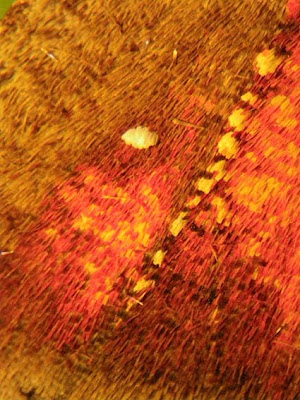I found this herald moth Scoliopteryx libatrix, with these beautiful orange markings on its wings, in my garden.
The whole moth is covered with scales, of various shapes, sizes and colours over its whole body, even to the extent that its legs are clothed in this rather fetching pattern of alternating black and white rings.
The main body is covered with fine hair-like scales, but the scales on the wings are....
... much broader, although they vary in width and colour. One interesting feature is that the patches of colour that look fiery orange to the naked eye are composed of a mixture of pinkish-red scales interspersed with variable numbers of yellow scales. The whole effect is reminiscent of colours produced in Pointillist paintings, of the kind made famous by George Seurat. By Seurat's day (1859-1891) the study of colour had revealed that the close juxtaposition of points of two colours could produce the effect of a third colour when viewed from a distance and Seurat exploited this in his meticulously executed paintings. The computer monitor screen that you are viewing this blogpost on uses a similar principle, of coloured dots, to produce its vast range of colours. Butterflies and moths have been exploiting the same phenomenon for millions of years, to either make themselves conspicuous to mates or generate camouflage patterns.
The herald moth's wings also carry small clusters of distinctive white scales, like those just above the 'orange' patch here, which I suspect may be scent scales that emit pheromones recognised by other individuals of the same species.



















The magnified images illustrate what we miss with normal vision. The patterns and texture are wonderful! Instances like this make me grateful for technology, enabling us to appreciate and enjoy what we would otherwise be unaware of.
ReplyDeleteHi Lesley, yes, your absolutely right, and it doesn't take much magnification to reveal something interesting...........
ReplyDelete